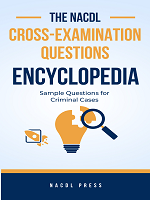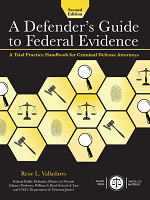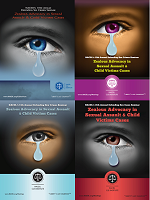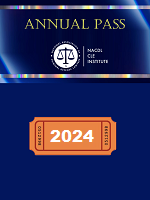Access to The Champion archive is one of many exclusive member benefits. It’s normally restricted to just NACDL members. However, this content, and others like it, is available to everyone in order to educate the public on why criminal justice reform is a necessity.
Babcock and Atwal Express Pride and Passion for Their Work
When some people in the indigent defense community speak of federal public defenders, there is often a twinge of jealousy because federal defender offices embody many of the ideals of parity and equality about which state public defenders can only dream. Federal defenders are generally paid at the same rate as their counterparts in the U.S. Attorney’s Office and their caseloads are measured by multiples of 10 rather than multiples of 100. Although many of their cases are more complicated, involving multimember drug or gang conspiracies, complex fraud schemes or high stakes terrorism cases, federal offices tend to be viewed as well staffed and well supported. The nature of the work and the opportunities the federal defenders provide draw some of the most knowledgeable, capable, and zealous advocates to these jobs. Two such advocates are Steven Babcock, an assistant federal defender in Billings, Mont., and Manvir (Manny) Atwal, an assistant federal defender in Minneapolis, Minn.
After growing up in Fairview, a small town on the eastern edge of Montana with a population of approximately 900, Babcock attended Minot State University in neighboring North Dakota. He remained there and attended law school at the University of North Dakota before returning home in 2001 to take the Montana Bar exam. After a year of clerking — and anxious to get into a courtroom — Babcock joined the Yellowstone County Public Defender’s Office. For three years he served as a state public defender before venturing briefly into private practice. In August 2005 he joined the Federal Defenders of Montana and has not looked back.
In contrast, Manny Atwal and her family lived in England until they immigrated to Oregon when she was in the sixth grade. She attended Oregon State University and entered William Mitchell Law School in St. Paul, Minn., with dreams of becoming an entertainment lawyer. “I was involved in Amnesty International in college and put together a benefit concert. I loved finding and booking bands and fell in love with the idea.” But during her first year of law school she began working at a Starbucks near a public defender’s office. With some encouragement from the attorneys, during her second year Atwal clerked for the Ramsey County Public Defender’s Office. “That was 1996, and I’ve never left public defender work.” Like Babcock, Atwal got her start in the state public defender system and after a few years migrated into her area’s federal defender office.
In the federal system there are two basic public defender models used to provide representation to indigent defendants: federal public defender offices and community defender organizations.1 Staff members at federal public defender offices are federal government employees and are led by a Federal Defender who is appointed to a four-year term by the circuit’s court of appeals. In contrast, community defender organizations are judicially independent, nonprofit corporations that are funded through an annual grant from the Administrative Office of the United States Courts. Montana employs the community defender model; Minnesota has federal defender offices. Although differing in name, their purpose is the same — to provide high quality representation to the indigent accused facing federal charges.
In addition to sharing the same goals as all indigent defense providers, the Montana and Minnesota federal defender offices share a more unique attribute in that both are heavily engaged in the representation of American Indians in federal court. American Indians and Alaska Natives make up approximately two percent of the U.S. population with 22 percent of them living on reservations or other trust lands.2
The representation of American Indians is a complex web of both legal and social proportions. On the legal side there is a matrix of factors that must be examined to determine who has jurisdiction over a matter. Beyond the jurisdictional challenges, this population presents unique social challenges as well. “Representing Native Americans is a family affair. It is essential to meet with the family and show respect. Otherwise a defender is easily marginalized as another white man out to get natives,” creating a level of distrust that prevents any meaningful representation, explained Montana Federal Defender Anthony Gallagher. Fortunately for their clients, both Babcock and Atwal have demonstrated an incredible ability to combine their legal skills with an understanding and appreciation of the human element of the job, and both have a passion for their American Indian clientele.
Steve’s ability to relate to his Native American clients likely comes from his own experiences growing up a mere 30 miles from the Sioux Reservation. He was familiar with much of the culture of Native Americans, going school with them and competing against them in athletics. Steve understands and appreciates their unique means of communication, their value system, and their wisdom. This has allowed him to provide representation with a level of compassion, understanding, tenacity, and strategy that has served his clients well, explained his supervisor, Mark Werner. “Steve is the kind of lawyer a person in trouble would seek to have by his side. He has judgment, guile, persuasive skills and, fortitude.”
In contrast, Atwal had her first contact with Native American clients when she began her federal practice. “It was quite shocking at first. On the reservation people leave their oven doors open for heat, have fly paper strips all about the home, and some homes don’t have running water,” she said.
According to data, the median income for all American Indian and Alaska Native families is $39,664. In comparison, the median income for non-Hispanic white families was $67,892.3 Nearly 28 percent of the Native American population lives at or below the poverty level. This is the highest rate of poverty for any racial group in the United States, nearly twice the national average (14.2 percent) and almost three times the rate for non-Hispanic whites (10.6 percent).4
“On my first trip to Red Lake Indian Reservation, my long hair got caught on some fly paper and I took down three ceiling tiles as I was screaming. Needless to say, my client was quite surprised by his attorney’s behavior, but that was 12 years ago.” Today Atwal is respected by her peers, her adversaries, and the judiciary. Most importantly, she is loved by her clients. “When I go to the reservation now, which is about five hours away, word travels fast because my car is seen on the reservation. My ‘work’ visits turn social, with prior clients stopping by to say hello or family members filling me in on the latest gossip.”
Atwal said she “had to learn quickly” that she could not judge. “I really had to listen and learn about the culture before I could defend my clients.” As important as it was for her to learn about her clients and their way of life, Atwal recognized it was just as critical to help the judge to understand and appreciate the situation. “Putting a judge in the shoes of a Red Lake client has been difficult,” she said. “However, making a sentencing video and really showing the judge the client’s life and lifestyle have helped.”
According to Gallagher, representation of American Indians represents approximately half of the Montana Community Defender caseload. As a result, the office is a hybrid between the traditional federal crimes and the “street crimes” such as burglary, sexual offenses, and larceny that normally constitute the bulk of a state defender caseload.5 However, all of these cases come with the specter of the harsh sentences that are frequently the hallmark of federal court. While the statistics in Minnesota more closely mirror the national patterns, this is likely the result of having just two of the state’s 11 tribal lands under federal jurisdiction.
Alarming for both states is the disproportionate rate of methamphetamine prosecutions. While the national average has methamphetamine representing 18.1 percent of federal drug cases, meth-related federal drug prosecutions in Minnesota hover near 40 percent and in Montana the rate is 53.4 percent.6 This is reflective of a growing trend of methamphetamine use and abuse by Indian populations7 and, as a result, brings a new dynamic to federal practice in these jurisdictions.8
“Indian Country cases are perhaps the most frustrating for me because of the unfairness. The federal sentencing guidelines are so much higher than the state sentences for the exact same behavior. It is so frustrating to explain this to a Red Lake client when I don’t understand why they are being treated so differently. It makes no sense,” Atwal said.
Reflecting on Babcock’s skills and attributes, Gallagher noted that Babcock “endeavors to be the most prepared lawyer in the courtroom, and always is.” He added that Babcock shows great originality in his motions practice. “He has initiative and drive and his ‘can do’ attitude is an asset to the organization. His litigation skills have earned the grudging respect of AUSAs and judges who appreciate his advocacy and zeal. Most importantly, his clients know they have a true advocate who will stand up for their rights and fight for them even in the most difficult of circumstances.”
Billings Assistant U.S. Attorney Jessica Fehr believes that Babcock is an exceptional lawyer. “Steve is the type of attorney you want on the other side. I know he will review discovery thoroughly, will establish a relationship with his client, and he will file any appropriate motions. If the case should plead, it does, and if it warrants a trial, it is guaranteed to be a good one.”
Atwal’s dedication and grit have similarly garnered the praise of her adversaries and the court. “Manny is compassionate about her cases and the clients she represents. She is widely respected by both the bench and the bar in Minnesota,” remarked Andrew Dunne, a 24-year veteran of the U.S. Attorney’s Office. W. Anders Folk, a former AUSA and Marine Corp JAG Officer, observed that “Manny’s skills include a balance of aggressive representation of her clients, a high level of technical legal proficiency, and the ability to empathize with her clients and understand their needs and goals for a case.”
Michael Davis, chief judge of the U.S. District Court for the District of Minnesota, agrees. Having served as a public defender himself, Judge Davis knows what it takes to be an indigent defender. “Manny works tirelessly to make even the most recalcitrant client relatable and to find the human connection. She is a true champion to her clients.”
For Babcock, the courtroom is a place to help make changes for individuals and communities. Coming from a family of teachers (including his grandmother, father, and sisters), Steve’s natural tendency is to use the courtroom to educate the judge, jurors, prosecutors, and sometimes even his clients about the fundamental rights to which every person is entitled. While both professions are underappreciated and undervalued by society, Babcock recognizes how much they are alike: “I quickly found out that this type of work is very humbling yet very rewarding. A single individual’s life can be positively and permanently impacted by a good public defender just like it could by one good teacher.”
While he enjoys the work, Babcock said that “one of the most difficult parts” of his job is being the constant bearer of bad news. “Many clients have no experience in the federal system. The amount of time people are facing is sometimes shocking to clients and especially their families.”
When asked to explain how he survives the day-to-day pressures of the job, Babcock said: “I would like to think that I am fluid. Wins in this system are relative. Sometimes a sentence of five years is a great victory.” He also indicated that his family and his involvement in the community outside of the legal profession help keep him grounded. For the past seven years Babcock has served as the play-by-play radio announcer for his local high school’s football team, enjoying a bit of the small town lifestyle to which he is accustomed.
Deputy Criminal Chief Assistant U.S. Attorney Lori Harper Suek, in charge of Montana’s Indian Country unit, described the work that Steve Babcock does by saying that he “accomplishes extraordinary things by doing ordinary everyday work exceptionally.”
For Atwal, “It’s hard for my family and friends to understand why I love defending people charged with serious crimes. I like the challenge of the law, but what makes my work as a public defender different than other attorneys is the clientele. I have the privilege to help people who may not have a single other person in their lives who cares about them.”
Being involved in her community, for Atwal, means being active in the legal community. Among other projects, she is a regular participant in the Federal Open Doors Program, which teaches kids about the careers in the federal criminal justice system.
“As a woman of color, I really want to reach out to students of color. I remember meeting with a group of girls from Somalia at one of the schools. They kept asking me if I worked for the lawyer or was a secretary. It was difficult for them to understand that I am an attorney,” she said. “After the school visit, the students participate in a mock trial with the attorneys at the federal courthouse. The female students from Somalia were shocked to see me going against a male prosecutor. Those girls walked away from the experience feeling they could do whatever they dreamed of. Over the years I have been able to keep in contact with some of the students. I am glad that as a public defender, I was able to give back to my community.”
“We will be known forever by the tracks we leave.” If this Dakota proverb is true, then Manny Atwal and Steve Babcock and all the indigent defenders they represent can hold their heads high. The path they have traveled on behalf of their clients is one that we would all travel down proudly.
This article is the last in the series highlighting Gideon’s Champions. The attorneys and offices profiled over the past year are merely a representative sample of the amazing work being done by indigent defenders in courtrooms across the country.
Notes
- Ninety-one of the 94 federal districts employ one of these two models. Three districts only employ CJA panel attorneys to handle indigent defense cases. There are 73 federal public defender offices and 18 community defender organizations.
- U.S. Department of Health and Human Services, Office of Minority Health (2010).
- Id.
- Id., National Indian Child Welfare Association, Data on American Indian Children and Families (2013).
- According to the U.S. Sentencing Commission data for FY2011 (U.S.S.C. Report FY2011), sexual assault cases made up only .5 percent of the federal caseload nationally, whereas it comprised 5.8 percent of Montana’s federal caseload, and child pornography, 2.2 percent of the federal caseload, was 7.7 percent of Montana’s caseload. Similarly, assaults nationally comprise .8 percent of the caseload but constituted 6.4 percent in Montana; burglaries .1 percent nationally, but 2.2 percent for Montana; and larcenies, 1.8 percent nationally, 4.2 percent for Montana.
- U.S.S.C. Report FY2011.
- Christopher B. Craven, Overcoming Legal Hurdles in the War Against Meth in Indian Country, 82 N.D. L. Rev. 1151 (2006). National Drug Intelligence Center data for June 2008 reflects that American Indian and Alaskan Natives between 18 and 25 years old use meth at a rate twice that of non-Indians (www.justice.gov/ndic/pubs29/29239/distro.htm).
- Data suggests the violent crime rate has increased between 10 and 20 times the national average as a result of drug trafficking related to methamphetamine; see http://www.ihs.gov/MedicalPrograms/Behavioral/documents/MethHotIssue3-30-05.pdf.






